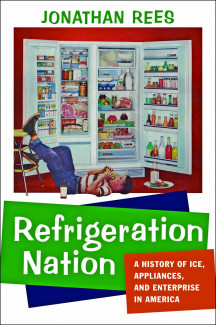
Johns Hopkins UniversityEst. 1876
America’s First Research University
Behind the book: 'Refrigeration Nation'

In the late-1990s, the fourth floor of the Engineering Library at the University of Wisconsin – Madison was filled with hundred-year old trade journals. I was writing a dissertation about the steel industry, but when you first came off the elevator right at eye level was a journal called Ice and Refrigeration. One day, I stopped to look at it and discovered a lost world of early five-ton refrigerating machines that seemed to have a habit of exploding. When I eventually started looking for a second book project, I decided to examine why. Many, many years later, the result was Refrigeration Nation.
The hardest thing to do when writing about the steel industry was finding something new to say about an industry that so many historians had covered before. The amazing thing about examining the history of refrigeration was just how little had been written about it before. The last academic examination of the ice and refrigeration industry had come out in the early-1950s. During all the years I worked on Refrigeration Nation, nothing new appeared.
The hardest thing about writing the book was determining the proper level of focus. The published sources on this industry proved voluminous. The private papers from refrigerating companies and engineers were less so, but still considerable. The only people I could talk to about how refrigerating machinery actually works were refrigerating engineers, who encouraged me to get into much more technological detail than I ever imagined possible.
What saved me from doing that was when I first discovered the idea of the cold chain. A “cold chain” is a refrigerating engineering concept that takes in all the infrastructure needed to transport and store perishable food from its point of production to its point of consumption. I used it as an organizing principle to describe the huge array of refrigeration-related technologies which make our modern cold chains possible.
Refrigeration Nation begins in 1806 with the beginnings of the early New England ice industry and progresses down the cold chain as time passes – moving from those giant ice machines, to refrigerated ships and railway cars and finally ending with the iceboxes and refrigerators that have marked the American kitchen for well over one hundred years. Sometimes I feel like a barely scratched the surface of everything I cover, but then again nobody had bothered to try to do even that before me for over fifty years.
Luckily, even in the two+ years since Refrigeration Nation appeared in hardback, a number of writers have taken up the challenge of improving our knowledge of this essential industry. My favorite is Carroll Gantz’s Refrigeration: A History (McFarland: 2015). I also like my own Refrigerator (Bloomsbury: 2015) for obvious reasons. I’m currently working on finishing a history of the American ice industry during the late-nineteenth and early-twentieth centuries for this very press again so that I can offer more detail than I did previously about this now-better known technological and industrial breakthrough. Hopefully the publication of the paperback edition of Refrigeration Nation will inspire even more work in this area, because there is certainly much left to be done.
Jonathan Rees is a professor of history at Colorado State University–Pueblo. He is the author of Industrialization and the Transformation of American Life: A Brief Introduction and Refrigerator and Refrigerator. His book, Refrigeration Nation: A History of Ice, Appliances, and Enterprise in America is now available in paperback.



